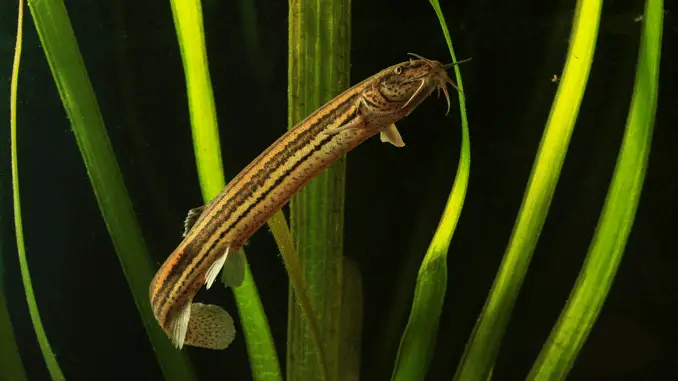
The dojo loach is a freshwater fish of the loach family.
This thin, slender fish is sometimes called the “weather loach” because it responds to changes in barometric pressure, and swims erratically or even stands on end when a storm is coming.
The dojo loach is popular among aquarists because of this behavior, which happens even in home aquariums. It comes in a variety of colors, and is a hardy fish that can live in a wide range of aquatic environments.
TABLE OF CONTENTS
Dojo Loach Facts & Overview
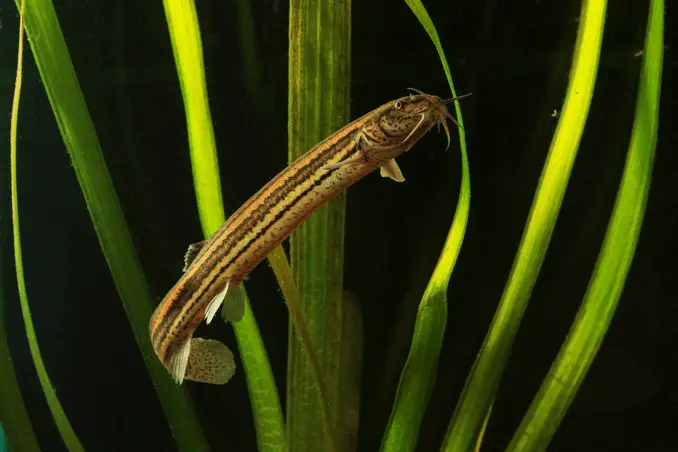
| Scientific name: | Misgurnus anguillicaudatus |
| Common names | Dojo loach, pond loach, weather loach |
| Distribution: | Siberia, Japan, Korea, China, and northern Vietnam |
| Size: | 6–12 inches |
| Life expectancy: | 7–10 years |
| Color: | Yellow, brown, light gray, or olive green, with lighter undersides |
| Diet: | Omnivore |
| Temperament: | Peaceful |
| Minimum tank size: | 55 gallons |
| Temperature: | 65–75°F (18–24°C) |
| pH: | 6.5–8.0 pH |
| Hardness: | 5–12 dGH (5-10 dGH is preferred) |
| Care level: | Easy |
| Breeding: | Egg-scatterer |
Origin
The dojo loach originates from shallow, slow-moving waters across eastern Asia. It’s native to rivers, streams, and ponds in Siberia, Japan, Korea, China, and northern Vietnam. The dojo loach has also been introduced into the wilds of the United States and Australia.
Dojo loaches are common in the wild, and can be found in many different aquatic environments. These hardy fish live in both cold and tropical waters, but they typically prefer slow-moving streams and ponds with muddy bottoms.
Adult Size & Lifespan
In a home aquarium, dojo loaches typically reach their full-grown adult size after three or four years. Wild dojo loaches grow larger than their aquarium-raised counterparts.
Both male and female dojo loaches grow as long as 6 inches in captivity, while in the wild, they reach up to 12 inches.
A dojo loach’s lifespan is heavily dependent on the quality and temperature of the water it lives in.
If a dojo loach is raised in its ideal temperature range of 68–72°F (20–22°C), it lives for up to ten years. A dojo loach is able to live in water temperatures of 65–75°F (18–24°C), but outside of its ideal temperature range, the fish only lives for four to five years.
Availability
Dojo loaches are not commonly available in pet stores, but most local pet stores are able to order them if you make a request.
A single dojo loach typically costs $7–$10, but because dojo loaches prefer to live in groups of three or more, you’ll likely need to spend $21–$30 and buy several fish.
You can also order them from the following sites:
- Arizona Aquatic Gardens sells a range of dojo loaches, including the golden variety
- LiveAquaria sells the common dojo loach, which can come in yellow, olive green, light gray, or brown
- FlipAquatics offers dojo loaches that are better suited for a tropical environment with a temperature range of 72–77°F
Dojo loaches are unavailable for purchase in New York, Illinois, Minnesota, and Michigan because they’re illegal to own in these states.
Appearance & Behavior
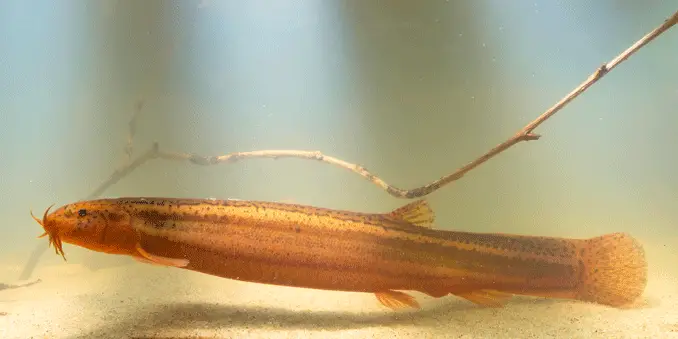
The dojo loach is often mistaken for an eel, because it has a long, rounded body with small fins. A dojo loach likes to dig and burrow in the substrate, but the fish comes out of hiding when it feels comfortable.
Colors, Patterns, Fins, and Sex Differences
The eel-like body of the dojo loach is long and slender, with small fins and a flattened tail. This fish has five pairs of barbels around its mouth.
The dojo loach comes in a variety of colors, including yellow, brown, olive green, and light gray, and both spotted markings and lighter undersides are common.
The golden dojo loach is another variety of this fish, which comes in orange-gold to pink-orange. Golden dojo loaches typically have longer, thinner bodies.
Males and females share the same body shape and coloring. However, male dojo loaches have longer, pointier pectoral fins, while females tend to have full-looking bellies.
Typical Behavior
Dojo loaches are peaceful, and get along well with other fish. They’re curious and playful, and they might swim up to your hands or eat from your palms once they’re comfortable.
Dojo loaches prefer to swim near the bottom of the tank, and like to dig around in the substrate. The substrate needs to be soft so that they can dig without injuring their thin scales.
Plants, driftwood, and other hiding spots give dojo loaches a place to relax. However, dojo loaches are not shy and typically swim around in the tank.
Dojo loaches are moderately fast swimmers, and they love to jump. If their aquarium tank is uncovered, dojo loaches frequently escape by jumping out and landing on the floor.
The dojo loach is a nocturnal fish. It can be fed at the same time as other fish, but it usually prefers to forage and scavenge around the tank.
Dojo loaches’ behavior before barometric pressure changes in the weather makes them popular fish for home aquarists. When heavy rain or storms are coming, the dojo loach swims erratically, and may even swim upright.
Dojo Loach Care & Tank Requirements
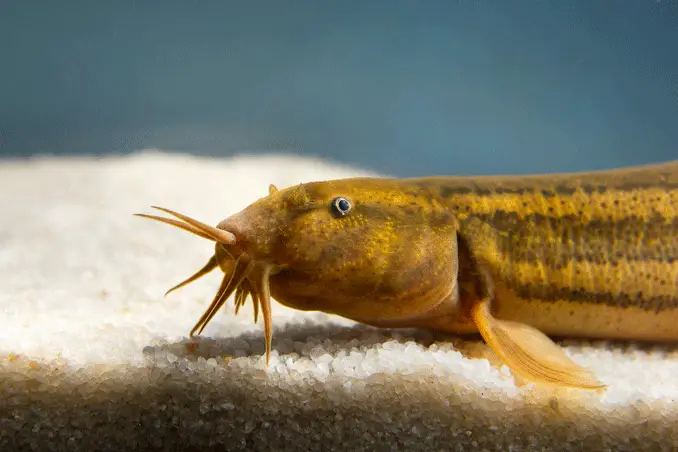
The dojo loach isn’t difficult to care for, and its hardiness in different environments makes it popular for beginner aquarists, but it requires a bigger maintenance commitment than other fish.
The most important requirement for the dojo loach is a constant supply of clean, fresh water. This fish needs weekly water changes of up to 30% of the tank capacity, otherwise it’s susceptible to illness.
In the wild, dojo loaches live at the bottom of shallow ponds, streams, and rivers, so they like to have nooks and crannies to explore for fun and food. Feeding them sinking foods, like live earthworms, shrimp, sinking pellets or tablets, and algae, is best.
Habitat and Tank Requirements
The natural habitat of the dojo loach is at the bottom of the water, so dojo loaches thrive in tanks that mimic this environment.
The ideal tank is at least four feet long rather than tall, and has a tight-fitting cover, because dojo loaches like to swim around and even jump out of their tanks. Adding hardy plants like algae, twisted roots, Java ferns, and cryptocoryne will give the dojo loach lots to explore.
Although they like to have driftwood or caves that can provide nooks and crannies to hide and play in, dojo loaches do not need a specific kind of decor in their tank.
With that said, dojo loaches should have soft sand or silt for substrate in their tanks, because they like to dig and slither through the substrate, and harder material could damage their thin scales.
Tank Conditions
The tank requirements for dojo loaches are listed below:
| Water type: | Soft to medium, fresh water |
| Tank size: | 55 gallons minimum, at least four feet long |
| Water temperature: | 50–82°F (10–27°C) but aim for 65–75°F (18–24°C) |
| Substrate: | Soft, like sand or silt, for burrowing |
| Tank setup: | Hardy rooted plants, smooth rocks, caves for exploration |
| Acidity: | 6.5–8.0 pH |
| Water hardness: | 5–12 dGH (5–10 dGH is preferred) |
| Filter: | Yes, to provide moderate flow |
| Bubbler: | Not essential, but can help |
| Lid: | Yes, well-fitted to prevent escape |
The tank needs to be set up to prevent escape, with a well-fitted lid in case the dojo loach tries to jump out, and filter tubes should be filled with sponge or filter screens, to prevent the dojo loach from swimming up the tubes.
Disease
The two most common diseases that affect the dojo loach are ich and skinny disease.
Ich
When a dojo loach develops ich, white specks will appear all over its body, like salt has been sprinkled on its scales. A dojo loach that has ich should be quarantined in a separate tank, so that it doesn’t infect other fish, and treated with an ich treatment like Ich-X.
Skinny Disease
A dojo loach with skinny disease will get thinner and thinner, even though it’s eating a plentiful, healthy diet. The affected dojo loach should be separated in a quarantine tank so that the skinny disease can be treated with medication.
There are two easy ways to prevent these diseases:
- Change the water in the tank weekly by 30% of the tank’s capacity
- Thoroughly wash and rinse any plants or decorations before introducing them to the tank
Tank Mates
Dojo loaches thrive in aquariums with plenty of other fish, especially if there are other dojo loaches. Dojo loaches in the same tank will lay together and chase each other playfully.
Peaceful, upper and middle dwelling fish are the best companions for these fish.
Great tank mates for a dojo loach include:
- Different varieties of goldfish
- Other dojo loaches
- Kuhli loaches
- Bitterlings
- Subtropical Danionins
- Rosy barbs
Aggressive fish should not be included in the tank with the dojo loach. Shrimp and snails should also be avoided as tank mates, unless they’re added for the dojo loach to eat.
Diet and Feeding
In the wild, dojo loaches are omnivores. They primarily feed on organic matter like algae as well as worms and small snails if available.
In a tank environment, their diet should be similar to a wild diet. Dojo loaches should have algae in their tank, as well as other plants and organic matter. You should also provide sinking food pellets or tablets for them to eat, and they can eat worms, small shrimp, or insect larvae as an occasional snack.
Dojo loaches should be fed three times a day, and their meals should have variety. They eat slowly, so sinking pellets or tablets are a great choice to make sure that they have food when in a tank with faster fish.
Breeding
Although dojo loaches reportedly breed in aquariums, not much is known about the process. They’re not bred commercially, and reports of captive breeding are rare.
If you want to breed your dojo loaches, be sure to sex all the fish to ensure that you are putting both males and females together in the tank.
Some dojo loach enthusiasts report that introducing cooler water during weekly water changes and then re-warming the tank to its optimal temperature seems to increase the chances of egg spawning.
Should You Get a Dojo Loach for Your Aquarium?
Aquarists of all experience levels can enjoy this curious and friendly fish in their home aquariums as long as they commit to keeping the water clean and changing it often.
If you’re looking for a peaceful bottom-dwelling fish to add to your tank, the dojo loach is a good choice to consider.

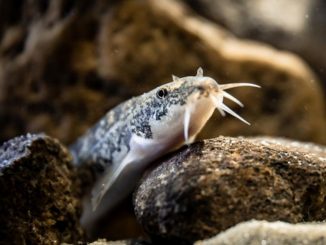
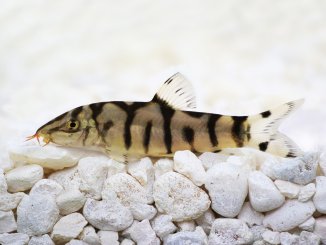
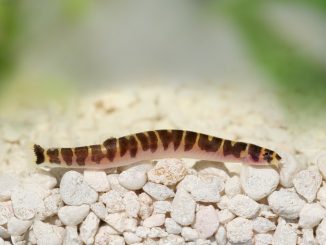
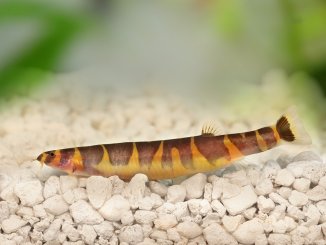
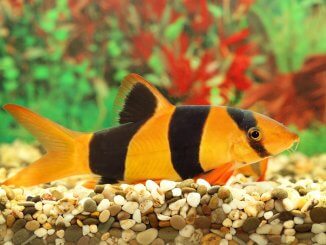
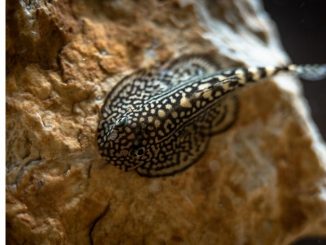
Be the first to comment